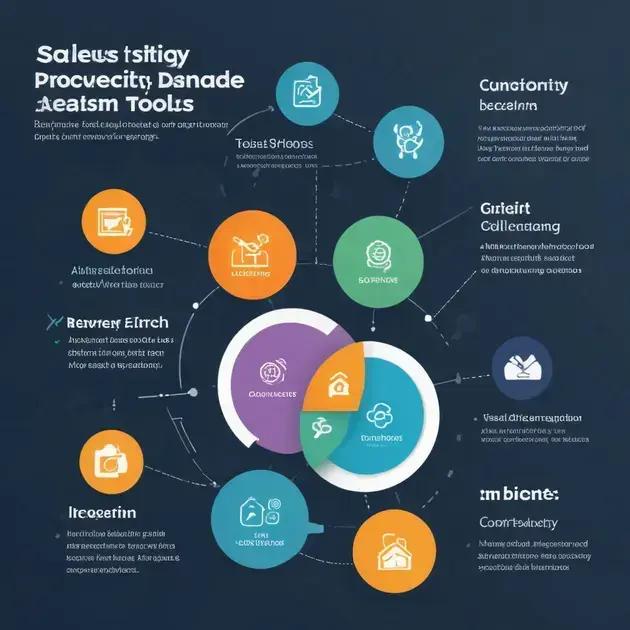Sales productivity tools are essential for enhancing efficiency and effectiveness in sales teams. These tools automate tasks, improve lead management, and provide insights, allowing teams to focus on building relationships and closing deals successfully.
Sales productivity tools are becoming increasingly vital in today’s fast-paced marketplace. These tools can help streamline processes, enhance customer interactions, and ultimately drive more sales. In this post, we’ll delve into what these tools are, highlight some of the best options available in 2023, and guide you on making the right choice for your team.
What Are Sales Productivity Tools?
Sales productivity tools are software applications designed to help sales teams operate more efficiently. These tools assist in streamlining workflows, managing contacts, and enhancing overall productivity. By utilizing technology, sales professionals can focus on what truly matters—closing deals and nurturing customer relationships.
Types of Sales Productivity Tools
There are several categories of sales productivity tools. Some of the most popular types include:
- CRM Software: Customer Relationship Management (CRM) tools help sales teams track customer interactions, store information, and manage relationships.
- Email Automation: These tools streamline communication by automating email campaigns, setting reminders, and following up with leads.
- Sales Analytics: Analytics tools provide insights into sales performance, helping teams make data-driven decisions.
- Project Management Tools: These help teams collaborate effectively, tracking tasks and deadlines to keep everyone on the same page.
- Lead Generation Tools: Tools that help identify and qualify potential leads, ensuring that sales teams are focusing on the right prospects.
Importance of Sales Productivity Tools
Embracing sales productivity tools can lead to significant improvements in efficiency. By automating repetitive tasks and providing useful insights, these tools allow sales professionals to dedicate more time to developing relationships and closing deals. The right tools can transform a sales team into a high-performing unit.
Choosing the Right Tool
When selecting a sales productivity tool, it’s important to consider your team’s specific needs. Evaluate factors such as ease of use, integration capabilities, and customer support options. A good fit will enhance productivity without overwhelming team members with unnecessary features.
Top 5 Sales Productivity Tools of 2023

As the sales industry evolves, so do the tools that aid sales professionals. In 2023, there are several key sales productivity tools that have proven to enhance efficiency and drive results. Here, we highlight the top five tools that can help sales teams achieve their goals.
1. HubSpot Sales
HubSpot Sales is a comprehensive CRM platform that provides a suite of productivity features, including email tracking, pipeline management, and document management. Its user-friendly interface makes it easy for sales teams to streamline their workflow and improve communication with leads.
2. Salesforce
Salesforce remains a leading name in sales productivity. This powerful CRM offers extensive customization options, enabling teams to tailor the platform to their specific needs. With features such as automation, real-time analytics, and integration capabilities, Salesforce helps sales professionals stay organized and focused.
3. Pipedrive
Pipedrive is designed to enhance sales pipeline management. Its visual dashboard allows sales teams to track their progress and prioritize tasks effectively. With automation features and easy collaboration options, Pipedrive is ideal for teams of all sizes.
4. ZoomInfo
ZoomInfo provides sales teams with access to a robust database of contacts and companies. This tool enables professionals to find and connect with high-quality leads quickly. With its advanced search features and data enrichment capabilities, ZoomInfo helps in targeting the right prospects.
5. Trello
Trello is a versatile project management tool that can be adapted for sales teams. With its card-based layout, teams can use Trello to manage tasks, track progress, and collaborate on deals in a visually intuitive way. Integrating with multiple apps enhances its functionality, making it a great choice for managing the sales process.
How to Choose the Right Sales Productivity Tool
Choosing the right sales productivity tool is essential for improving efficiency and maximizing your sales team’s potential. Here are key factors to consider when making this important decision.
1. Assess Your Team’s Needs
Start by understanding the specific challenges your sales team faces. Are they struggling with lead management, communication, or follow-up tasks? Knowing the pain points will help you identify which features are most necessary.
2. Consider Usability
The tool should be user-friendly so that your sales team can adopt it quickly. A complicated interface can lead to frustration and decreased productivity. Look for tools that offer intuitive designs and require minimal training.
3. Integration Capabilities
Your chosen tool should seamlessly integrate with existing systems, such as CRM software, email platforms, and calendar applications. This ensures a smooth workflow and prevents data silos, allowing for efficient information sharing.
4. Scalability
Choose a tool that can grow with your business. As your team expands or your needs change, the tool should be able to accommodate increased users and added functionalities without significant disruptions.
5. Cost-Benefit Analysis
Evaluate the cost against the benefits the tool provides. Look for pricing plans that fit your budget while offering the features you need. Consider trial versions to assess effectiveness before committing long-term.
By considering these factors, you can make an informed decision, ensuring that the sales productivity tool you select enhances your team’s efficiency and contributes to overall success.
Benefits of Implementing Sales Productivity Tools

Implementing sales productivity tools can significantly enhance the effectiveness of a sales team. Here are some key benefits of using these tools in your sales operations.
1. Increased Efficiency
Sales productivity tools automate repetitive tasks like data entry and follow-ups. By reducing manual work, salespeople can focus on building relationships and closing deals, which ultimately leads to higher productivity.
2. Improved Lead Management
These tools help in organizing leads and tracking their progress throughout the sales funnel. Enhanced lead management capabilities ensure that no potential client is overlooked, allowing for better follow-up strategies.
3. Enhanced Collaboration
Sales productivity tools often include features that facilitate communication and collaboration among team members. This helps in sharing updates, strategies, and insights, which can lead to more effective teamwork.
4. Data-Driven Insights
Many sales productivity tools come equipped with analytics features. These tools can track performance metrics, provide insights into customer behavior, and help in making data-driven decisions that can lead to better sales strategies.
5. Better Customer Engagement
With the help of sales productivity tools, teams can personalize their communication and engagement tactics. By understanding customer needs and preferences, salespeople can tailor their approach, leading to improved customer satisfaction and loyalty.
Overall, the implementation of sales productivity tools contributes to a more efficient, organized, and successful sales process.
Future Trends in Sales Productivity Tools
The landscape of sales productivity tools is rapidly evolving, influenced by technological advancements and changing market demands. Here are some future trends that are shaping the tools sales teams will use in the coming years.
1. Integration of Artificial Intelligence
AI technologies are becoming increasingly integrated into sales productivity tools. This allows for smarter analytics, predictive lead scoring, and enhanced customer insights. AI can automate time-consuming tasks, enabling sales teams to focus on strategy and engagement.
2. Enhanced Mobile Capabilities
As remote work becomes more common, mobile access to sales tools is critical. Future sales productivity tools will prioritize mobile functionality, enabling sales reps to access essential information and manage tasks from anywhere, ensuring they remain productive on the go.
3. Focus on Data Privacy
As data regulations become stricter, sales productivity tools will place greater emphasis on data privacy and security. Companies will need to ensure that their tools comply with relevant laws and protect customer information to build trust and maintain compliance.
4. Greater Emphasis on Collaboration
Collaboration features will become more sophisticated, allowing teams to work together seamlessly across different locations. Future tools will likely include real-time collaboration capabilities, such as shared dashboards and integrated communication systems, enhancing teamwork.
5. User-Centric Design
The design of sales productivity tools will focus more on user experience. Tools will be developed with user feedback in mind to ensure they are easy to use and effectively meet the needs of sales teams. This will increase adoption rates and overall efficiency.
Staying ahead of these trends will ensure that sales teams are equipped with the best tools available, optimizing productivity and growing their success in an ever-changing market.
Embracing Sales Productivity Tools for Success
Utilizing sales productivity tools can significantly boost the efficiency and effectiveness of your sales efforts. By automating tasks, improving lead management, and enabling better collaboration, these tools empower sales teams to focus on what really matters: connecting with customers and closing deals.
As the future unfolds, staying updated with the latest trends, such as AI integration and user-centric designs, will ensure your team remains competitive and productive.
Incorporating the right tools into your sales strategy can lead to greater success and help your business thrive in a challenging marketplace.
FAQ – Frequently Asked Questions about Sales Productivity Tools
What are sales productivity tools?
Sales productivity tools are software applications designed to help sales teams manage their workflows, improve efficiency, and enhance customer interactions.
How can sales productivity tools improve team efficiency?
These tools automate repetitive tasks, streamline communication, and provide valuable insights, allowing sales teams to focus more on selling and less on administrative duties.
What should I consider when choosing a sales productivity tool?
Consider factors like your team’s specific needs, usability, integration capabilities, scalability, and the cost versus benefits when selecting a tool.
Will integrating AI into sales tools benefit my team?
Yes, AI can automate various processes, provide predictive analytics, and offer insights that help sales teams make better decisions and increase productivity.
How can mobile capabilities enhance sales productivity?
Mobile capabilities allow sales reps to access tools and information on the go, ensuring they can manage their tasks and communicate effectively wherever they are.
What future trends should I watch for in sales productivity tools?
Look out for trends like AI integration, enhanced mobile capabilities, greater collaboration features, and user-centric designs, which will shape the future of sales productivity.




